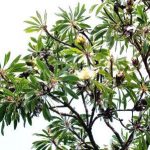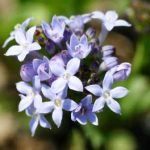TREE LIFE
June 2006
Please note that with immediate effect the post office box number for the Tree Society has changed to:
P.O. BOX A 273 AVONDALE HARARE
MASHONALAND CALENDAR
Saturday 3rd June Botanic Garden Walk. Meet Tom in the car park at 10.45 for 11 am. We will continue with another instalment of the fig family – Moraceae.
Sunday 18th June Return visit to Mazvikadei Dam near Banket. There is accommodation available for a few members to spend the weekend. Please contact Adele if you wish to reserve a space. It will be self-catering.
Members will be welcome to join us for the day. We will meet at Stand No. 139 at 9.30 a.m.
Saturday 24th June By kind permission of Anne and Nigel Lowe, Mark’s Walk is at their home on the Darama Rd near Christon Bank. This is a return visit to the area we were shown by Anne after lunch when we fled to their home because of rain at the January outing.
MATABELELAND CALENDAR.
Please contact Jean Wiley or Gill Short for details of the next Matabeleland function.
REMINDER OF SUBSCRIPTIONS FOR 2006/7
Email Z$160,000
Printed copy: collected Z$320,000
Printed copy: posted Z$800,000
If paying by cheque, please make it out to CABS and on the reverse ‘Pay to the account of the Tree Society’
Mark Hyde
VUMBA SPECIAL ( new series)
This is the first article in an occasional, more light-hearted series about trees in the Vumba, written by our member Bart Wursten
The first item on the menu is Peddiea africana, Green flower Tree, Poison Olive
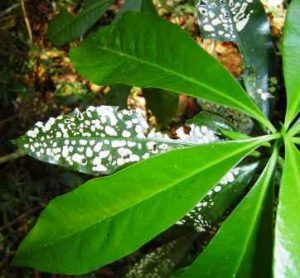
Peddiea africana. Photo: Bart Wursten. Source: Flora of Zimbabwe
If plants were allowed to be frustrated and a bit depressed, Peddiea africana might have been a regular client for the vegetative shrink. Most of its cousins in the Thymelaeaceae family openly display their arrogant beauty in bright balls of orange, pink and yellow, while Peddiea shyly hides in the understorey of the Vumba forests. Normally, being a small, nondescript shrub, it only barely made it into the tree books, where it got stuck with nicknames like Green-flower Tree or Poison Olive.
Sometimes, a group of people comes to visit the forest and, if they don’t ignore poor Peddiea altogether, their leader might decide to tear off one of its branches. This serves to show the others that, if you do that and all the bark strips away, you know that it was Peddiea, and it obviously doesn’t like having its limbs ripped off. “All trees have labels”, calls out one of the book-writing ladies, who had walked straight past at first, because it wasn’t big enough.
Peddiea, however, has not always been ignored. One small insect is particularly fond of it and raises its brood on the leaves of Peddiea and wants no other. In the process it colours the leaves with bright white spots. Scientists, will want to call this “an act of species-specific parasitism”. Hey! What do they know? Peddiea is quite happy with being instantly recognizable without it literally costing an arm and a leg.
If plants were allowed to think and fight for their rights, Peddiea might have thought of this, rather brilliant little plan all by itself.
Do you want to have a look at Peddiea africana, or its fancy cousins? Check out www.zimbabweflora.co.zw, or come and stay at Ndundu Lodge in the Vumba.
-Bart Wursten
MUKUVISI WOODLAND: SUNDAY, 9 APRIL 2006
Meg Coates Palgrave very kindly stepped in to lead this outing as I was expecting to be away. However, plans changed and I was fortunate enough to be able to attend.
We visited an old stamping ground, the Mukuvisi Woodland and entered by the Blatherwick Avenue gate.
Although we were not far into double figures in numbers, we had a most memorable day in which a large number of interesting plants were seen. The bush, although drying up somewhat, was still thick and luxuriant after the good rainy season, and throughout the walk we continually kept encountering interesting woody and herbaceous species.
This area is, in my view, one of the best botanical areas within the city of Harare. There were times, enclosed in the thick vegetation, when it was very hard to believe that we were in the City.
Meg first discussed the interesting crop of non-native trees which grow near the Blatherwick Avenue gate. I had always suspected that they might have been planted but hadn’t actually known for certain.
Meg informed us that these trees had been planted in c.1981-2. Indeed, some of the plants had actually been given to the Woodlands by Meg.
There were are 5 species involved and these are now discussed in turn.
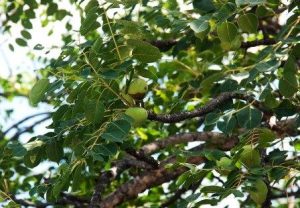
Sclerocarya birrea subsp. caffra. Photo: Bart Wursten. Source: Flora of Zimbabwe
Sclerocarya birrea subsp. caffra (marula) has a 1-pinnate leaf and, specifically, an imparipinnate leaf, i.e. it has a terminal leaflet. Generally, in mature leaves, the leaflets are entire and this serves to distinguish the species from the somewhat similar leaves of Kirkia acuminata (kirkia) which are markedly serrate.
Unfortunately, young leaves or leaves from coppice growth of the marula are sometimes markedly toothed as well, so this method is not foolproof.
Marula generally prefers a lower altitude than the Mukuvisi Woodlands (1490 m here) and does not naturally occur near Harare.
Interestingly, it is said that the marula can be ring-barked and will survive. It is grown commercially, at least in S Africa, where the fruits are harvested for making liqueurs (Amarula).
It is a dioecious species with male and female flowers on separate trees. This particular tree is about 6 m high – and is over 20 years old, suggesting a slow rate of growth.
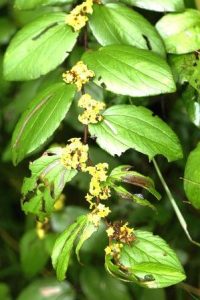
Ziziphus abyssinica. Photo: Bart Wursten. Source: Flora of Zimbabwe
Ziziphus abyssinica (the Large jujube) is a species of the Valley and appeared to be doing well. The leaves are 3-veined from the base with the veins deeply impressed – this distinguishes it from the common Z. mucronata. The base is strongly asymmetric. The leaves are green above and grey beneath.
The flowers are small and yellow. Like other Ziziphus species, the tree is spiny with pairs of spines, one pointing forward, the other back.
Ficus ingens (Red-leaved fig) is another of the planted species. This just could be a native species in this area, although it certainly isn’t common in the Harare area.
Like most figs, this has milky sap with a prominent terminal stipule. The origin of the English name is that the young leaves are often a brownish-red colour. The veins beneath the leaf are strongly raised and the fruits are pink when ripe.
Meg pointed out that most figs, including ingens, are 3-veined at the base. The group of species which are not 3-veined are the ‘thonningii’ group – including F. burkei, natalensis etc.
Dalbergia sissoo is a native of SE Asia. Although planted here, there is a record of it escaped somewhere in Zimbabwe so that it features for example on Bob Drummond’s lists of Zimbabwean woody plants. Its flowers are small and creamy yellow, the leaves are pinnate with the typical subopposite to alternate leaflets and it has flattened winged pods.
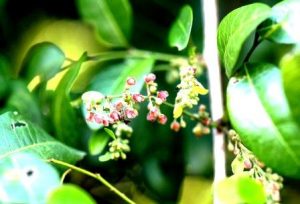
Phyllanthus reticulatus. Photo: Bart Wursten. Source: Flora of Zimbabwe
Phyllanthus reticulatus is the familiar and characteristic Potato-smell of lowveld rivers. Again, it is not a species you see around Harare, but you probably don’t have to drop down far in altitude before it would begin to appear.
Phyllanthus species have the unusual characteristic of appearing to have pinnate leaves; this is especially confusing as the shoots themselves may be deciduous.
Close to the planted trees was a medium-sized Acacia galpinii. Possibly this too was planted. However, it possibly could occur as a native species in this habitat.
This bears prickles like a rose and they in theory can be reasonably easily detached (this one was less than cooperative). Meg explained that albizias always have glands on either petiole or rhachis, whereas acacias only do sometimes. Glands are extra-floral nectaries; that is nectar produced outside the flower and they serve to attract ants.
Taxonomically, they are not often very useful in acacias. However, they may assist in separating schweinfurthii and ataxacantha; polyacantha has a particularly large gland and their position assists in separating the two wattles, dealbata and mearnsii.
We then headed back past the cars and crossed the bridge into open sandy miombo woodland on the other side.
Here was where a group of friends had in February of this year, scattered the ashes of Sally Perrett. And what a beautiful place it is for a memorial.
A very pretty flower here was the orange-flowered composite, Hypericophyllum compositarum. This has opposite leaves (a less frequent arrangement in Compositae than the more usual alternate arrangement). The generic name means ‘with leaves like a Hypericum’. I’m not sure which species was intended but broad opposite leaves like these are not unusual in that genus.
Here also was Strychnos cocculoides (with its exceptionally corky bark) and Burkea africana (2-pinnate leaves, alternate leaflets and reddish-brown tips).
We came across a tree of Pterocarpus rotundifolius (the round-leaved bloodwood). This flowers in the hot dry season (Nov / Dec) often appearing after the first showers of rain. Ours is subspecies rotundifolius, which has relatively few (5-7) round leaflets.
Meg mentioned another subspecies, namely subsp. martinii, which has more (9-13) leaflets which are ovate. This subspecies also differs in flowering at a completely different time, namely in February. Perhaps it deserves the rank of full species?
A similar discussion took place a little while later as we entered a rather dry vlei. Here was the subspecies huillense of Syzygium guineense which is a suffrutex. In this case also, Meg prefers to treat this as a full species, namely Syzygium huillense, although in Trees of Southern Africa, she does retain the subspecies.
Bernard Beakes was particularly interested in the species of protea in the woodland and some discussion took place. Here we saw Protea welwitschii in flower. Meg explained that the 4 taxa which occur around Harare flower at different and characteristic times as follows:
angolensis var. divaricata (the shrub) Mid-year (i.e. winter-flowering)
angolensis var. angolensis (the suffrutex) Dec / Jan
gaguedi Nov / Dec (before Xmas)
welwitschii Jan – Apr (after Xmas)
It’s interesting how the two varieties of Protea angolensis flower at totally different times.
Later, we were to see both P. angolensis var. divaricata and P. gaguedi.
Here we came across a strangler fig, namely Ficus burkei, which Meg had mentioned earlier. We were able to see that it was not 3-veined from the base; furthermore it looks as if the petiole has been stuck on to the leaf blade.
From there we walked back through the woodland, eventually reaching the Mukuvisi River. A long list of herbaceous species was recorded.
Then, back to the cars for lunch. Afterwards, I had to leave, so I don’t know whether a further walk took place in the afternoon.
I enjoyed the walk very much. Special thanks must go to Meg for a fascinating morning.
-Mark Hyde
Lynn Mullin’s talk to the Tree Society given in about 1977. Continued (the third and final part).
One never would cut the trees down at the very young age of 5 or 6 years for Sawmill timber; but for certain classes of poles this is already being done regularly and I quote Timaru plantation in Makoni T.T.L. as an example.
Nevertheless whether felled or not the volume would be standing on the ground.
Take as an extreme example the enormous Eucalyptus already mentioned as growing at the late Mr. John Meikle’s farm Mountain Home. Some of these trees are now almost, if not quite 300 feet in height, and up to 6 feet and more in diameter. Such a single tree has a volume of at least 2500 cu.ft Thus one tree, one tree mark you, at little more than half the age of the acre of savannah woodland has almost double the volume. The particular stand in which these monsters are growing shows a Mean Annual Increment of some 867 cu. ft, almost exactly 62 times as much as our savannah woodland. At the time Mr. Meikle’s trees were measured in 1958, 54 years after planting, the volume of timber per acre stood at 47700 cu. ft. If this stand is allowed to reach 100 years of age it might then carry 88440 cu. ft. per acre, again about 62 times as much timber as the acre of savannah.
I think these figures, fascinating as our indigenous woodland may be and valuable as it may be before exploitation, do prove how uneconomical it would be to try to regenerate them artificially.
So far I have tried to give you a picture of why our natural timber resources are dwindling and why it is virtually impossible to stop this without calling a halt to exploitation altogether. We live in a rapidly changing world and the loss of our indigenous woodland is one of these changes I am afraid we shall have to reluctantly accept.
I should like to say a few words about the vernacular names of some of our trees and their meanings and, in one or two cases, suggest how the names were derived. Take for instance the Musasa, the Sezuru or Shona name for a temporary camp, or roughly constructed shelter, is Musasa, and I feel that this tree being the commonest in the country and so most readily available for putting up these rough shelters was given this name very early in the history of tribal movement in this part of Africa.
Still using the same tree, the Sindebele name of which is Igonde. I am sure this name was derived from the fact that it was the most abundant tree in Chief Lomagonde’s domain when the Matabele came into the country from the south. The Sindebele plural for a forest of these trees is Mogonde.
There are several trees which have names meaning the same thing in many languages and Mukwa is one of these, though what Mukwa itself means I do not know. Its Shona name of Mubvamoropa and its Sindebele name of Umvagasi and its European name of Bloodwood are all derived from the fact that when the tree is cut the red sap pours out and looks like blood.
Then there is Mudtyamwhembwe, Pseudolachnostylis maprouneifolia. The above is Shona, the Sindebele is Qobampunzi and the Afrikaans is Duiker-kos, all meaning the same things, Duiker’s food. And there are many other similar instances but I think this will suffice to show how interesting the collecting of vernacular names can be. I have always been interested in this and have always enjoyed it as a hobby.
I would urge you all never to pass a tree you do not know simply because you feel everybody else must know it and it is probably of no real interest. As a case in point I will tell you of a recent experience of my own. I was asked to give advice on a farm in the Headlands District in March last year and upon arrival at the homestead I had noticed a grove of large trees some two hundred yards away from the house but had not given them another thought. Later, in the course of conversation, I asked the farmer the name of his farm and was surprised when he answered “Sandalboom”. I immediately said, “how did it get that name? I am sure there are no Sandalwood trees growing here”. “Oh yes there are”, was his reply and when I said I should like to see them if it were easily possible, he said it was as they were close to the house.
What was my surprise when he led me straight to the grove which I had already seen. I knew immediately that they were not Sandalwood Spirostachys africana; but one of the Albizias; unknown to me, but I said I would soon find out and let him know. Anyway, to cut a long story short, this small grove of very large Albizias only 2 ½ miles from the main Salisbury/Umtali road, had never before been noticed. I collected specimens which Mr. Drummond of the Herbarium was quite excited about. He thought then it was a new record and the specimens were to go to Kew for identification, later, however, he identified them as Albizia forbesii, which strangely enough, like the Sandalwood, is a lowveld species. So though not new to Rhodesia it is still a new record for that part of the country.
This tree is unknown to the Africans in the area who have always referred to it as Mutimumwe (another tree). It is revered by them as the rainmakers tree and was always, prior to the European entering the country, used as an Indaba site by the local Chiefs. The Africans will not touch the tree and I had to climb it myself to collect my specimens.
-Lyn Mullin
MARK HYDE CHAIRMAN


